Advertisement
With the April 4 opening of Tron: Lightcycle / Run I am once again too far away to be part of Walt Disney World history. First, it was a long time after the opening of Galaxy's Edge that I finally got to experience the new Star Wars attractions. Now, something I didn't believe would ever happen: a ride based on one of my other favorite movies is about to open in Florida! Alas, it will be some time before I get "on the grid" so as always, I'll be here contemplating things from afar.
So this perpetual being-away-from-the-park time got me thinking about the movie itself—TRON—and why I love it so much. At the same time, I couldn't help but relate it to Star Wars because I experienced the movies around the same time. TRON was released in 1982, right between The Empire Strikes Back (1980) and Return of the Jedi (1983). Needless to say, nostalgia plays a big factor here, but TRON has aged quite well over time. It holds up to modern lens and explores more universal ideas than what it shows on its surface. Like Star Wars, it has a bit more modern myth than science fiction.
With TRON, Disney took a major risk with the ambitious director, Steven Lisberger, and with the filming process that utilized computer-generated imagery and extensive animation/live-action techniques. The details of the production are the stuff of books and documentaries that I can't cover here, but in a larger sense, Disney saw an opportunity with TRON to release something daring—maybe even something that could become their epic fantasy.
The similarities between these two stories are not simply ideas copied from one to another. The motifs and story arcs are more universal to classic fables and fairy tales, and while both films take these stories and fashion them in different ways, the essence of the conflicts is portrayed in similiar ways.
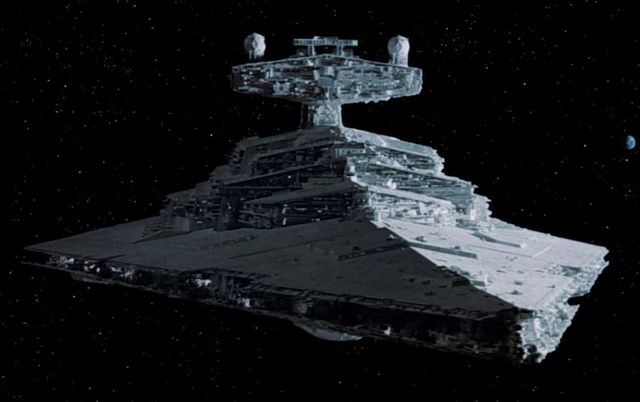
Darth Vader's Star Destroyer. © Lucasfilm.
Oppressive Overlord
In TRON, the main antagonistic force is the Master Control Program, or MCP. It is the operating system of the fictional Encom corporation in the movie, and all the employees have to interface with it for their work. The operating system is just a facade for its sinister goals. Using its developing artificial intelligence, the MCP has already infiltrated networks of banks, businesses, and corporations to feed its desire for knowledge and control. In every system it hacks, it takes their programs and if they're useful to him, he absorbs them; if they're not useful, he sends them into the video game grid to see how they fare in things like Pong and Lightcycles. Spoilers: they usually just die.
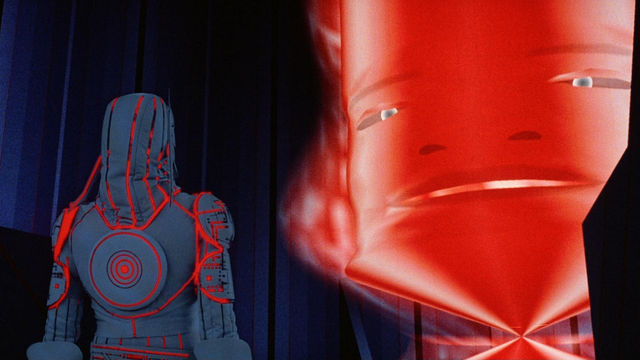
The Master Control Program. © Disney.
In the human world, the MCP was created by Ed Dillinger who, after stealing other users' programs—including Kevin Flynn's video games—made himself valuable to the company and eventually rose to to be the top executive. Then, he fired Flynn. Together, Dillinger and the MCP are set to take over the tech world—that is, until, the MCP wants to take over more than that. It begins to infiltrate government systems like the Pentagon and even gets into international agencies like the Kremlin in the then-USSR. It wants to take over the world!
It's not so different in Star Wars, where the galaxy is ruled by the tyrannical Empire that takes over everyone's lives. Its facade is one of keeping peace but its evil goal is to take over and maintain control over the entire galaxy. If any planetary "systems" joins the Empire, they reap the benefits of opressive rule. If any systems defy the Empire, they are blown up by the Death Star. No games, just destruction. Soon after the Death Star is complete, the Empire dissolves the old Senate so that all dissenting voices are silenced.
The Empire was the brainchild of Palpatine, who lied and used subterfuge to rise to become the top leader of the Old Republic. Then, he created a war so that a he could fill its eventual power vacuum by eliminating his enemies, the Jedi. Like the MCP, Palpatine has an insatiable hunger for power and control. Both are out to stop the spirit of the individual and make everything/everyone part of a machine. Both of these entities also have subordinates who carry out their wishes. Darth Vader answers to the Emperor and does his bidding. Dillinger answers to Master Control, and so does his doppelganger in the computer, Sark. Their interactions are shaky and tense, but usually end with evil purpose.
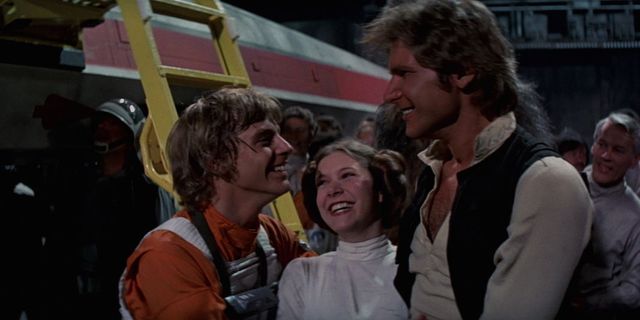
Luke, Leia, and Han. © Lucasfilm.

Alan, Flynn, and Lora. © Disney.
Heroes and Friends
Luke Skywalker and Kevin Flynn share some outstanding qualities. Flynn was "Encom's brightest young software engineer" when he was fired and shut out of the system. He lived on the other side of town in an arcade. That may sound fun but he wasn't happy, especially since he couldn't profit from his own creative works (Dillinger plagiarized Flynn's video games and got all the credit). While he was away from the center of that world, he was on the outside looking in trying to find a way out of his situation to better his life and the lives of others. Soon, Flynn is zapped into the world of the computer, on his way to adventure and danger.
Luke was also shut out of the system living on Tatooine, a planet on the other side of the galaxy from all the activity and happenings. He, too, wasn't happy, and was trying to better his situation—but he couldn't leave home and couldn't use his piloting skills to help himself or anyone. He was on the outside always looking to the horizon, longing for a better life. In a short time, he was zapped through hyperspace to another world on his way to adventure and danger.
Both Luke and Flynn are joined by friends along their journey, namely Han and Leia with Luke, and Alan and Lora with Flynn. The trios share a similar makeup. Han is sometimes described as a "cowboy" in space and in TRON, at one point, Alan describes Flynn as someone "playing space cowboy in some backroom." Flynn and Alan don't equate to Han and Luke, but the essences of the character traits are mixed between them. Alan is a bit more no-nonsense but hates the oversight of the MCP. So much so that the main program Alan creates is one that can keep security between all systems, something that could possibly undermine the MCP's ambitions. That program is named Tron.
Luke and Han are joined by Leia, who is not your typical princess. She's a leader of the Rebellion and sacrifices her own safety to be sure the Death Star plans do not fall back into the hands of the Empire. She holds the key that helps us learn how to defeat the enemy. In TRON, Lora is a computer scientist having just invented a laser-digitizing process, her "life's work." To try and infiltrate the MCP, Lora sacrifices her own safety by sneaking Flynn and Alan into the Encom building so they can hack the system from the inside. She holds the key that helps us learn how to defeat the enemy. Likewise, her program counterpart within the computer, Yori, also leads the way to victory when she takes Tron to a communication tower in order to learn how to beat the MCP. She then pilots two different ships to not only escape from the enemy but to set an attack on that same enemy.
These trios use their cunning and skills to counter the antagonists and, with trust and teamwork, finally set things right and bring freedom to their respective systems. Both sets of heroes are rewarded at the end. Leia awards Han and Luke with medals of honor and they become part of the continued rebellion. At the closing ceremony, while all the pomp and circumstance is going on, they share friendly knowing looks with each other that show their strong bonds of friendship. Flynn is finally exonerated and so when the truth is revealed about his contributions to the company, he becomes the new executive and the first thing he does is greet his friends, Alan and Lora, with a joyful hug.
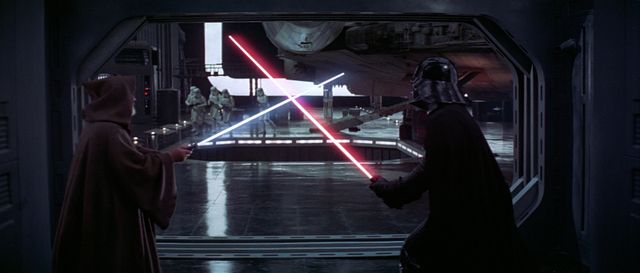
Obi-Wan faces Vader in a lightsaber duel. © Lucasfilm.

Tron holds his Identity Disc. © Disney.
Enemy Forces and Weapons
When we first meet Luke in Star Wars, the Empire is already ruling most of the galaxy and they're on the brink of complete dominance with its planet-killing weapon on the Death Star. In order to have any chance against the terror, the heroes must be equipped with weapons of their own. Luke possesses a lot of potential in the Force, but until he masters it, he fights off enemies with laser blasters. In order to bring him closer to the Force, Obi-Wan Kenobi not only teaches Luke about the mystical power, but also passes on to him the Jedi weapon: the lightsaber. It's a mix of old and new: medieval swords and new technology. The lightsaber in question once belonged to Luke's father, so it was also a source of inspiration on his journey.
When we first meet Flynn in TRON, the MCP is already taking over Encom, but it's on the brink of complete tech dominance with its program-eating AI. The weapons in TRON are also a mix of old and new but seem a bit more tame than a laser sword. That is, until you see what they do. The programs in the TRON world are equipped with identity discs. In computer terms, a disc is a major component of its functionality (well, it was, since many hard drives these days are "solid state" and not discs) and in the movie, they serve a similar purpose. Any thing a program learns is saved to the memory of the disc (like what a real computer disc would do). It also saves the program's action history—everything they do is logged on it—again, similar to our computers now. For the humanoid programs, the disc itself looks like a frisbee. But this flying disc doesn't necessarily behave like an ordinary frisbee. It is a mix of old and new: it's a frisbee but it lights up, "derezzes" enemy programs, and returns to its user. For the final battle, Tron communicates with Alan, his user, and obtains instructions on the disc about how to take down the MCP. Alan is like Tron's father, and Tron just received knowledge and power via a special weapon. The disc now also took on a symbol of inspiration for his journey. Classic mythological stuff.
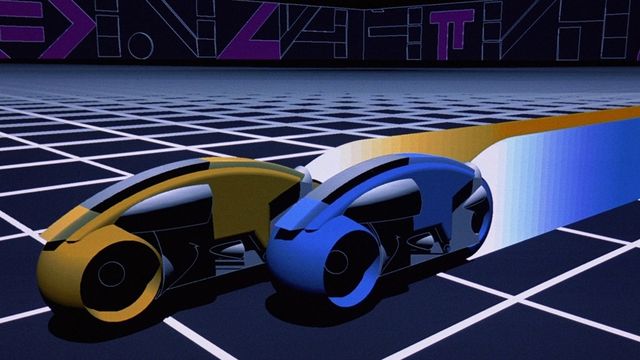
TRON original lightcycles. © Disney.
Various Similarities
While TRON and Star Wars share ideas and themes, their presentations are quite different. One sprawls across space and planets, the other across memories and microcircuits. Even so, some designs in the production overlap. Both movies are known for high-speed chases. Luke pilots his X-Wing fighter down the trench of the Death Star at amazing speed. One of the most famous scenes in TRON--which you've probably seeb even if you haven't seen the entire film--is the lightcycle sequence. And hey, the Disney park ride is based on it... well, based on the lightcycle battle from TRON Legacy but we'll talk about that next time. Flynn, Tron, and fellow conscript Ram race against the MCP's reprogrammed minions in a life-and-death battle of bikes that spurn out "jet" walls that the combatants can crash into. The 90-degree turns and narrow escapes make it a tense scene. The following year, in Return of the Jedi, we would see high-speed bikes racing through a forest full of trees to crash into.
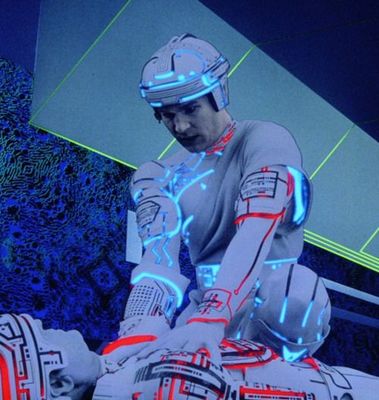
Flynn takes a disguise by changing color. © Disney.
The color schemes of TRON could have been influenced by Star Wars in a particular way. In early production of TRON, the circuits on the armor of the good guys was going to be orange or red, and the bad guys were to glow blue. However, Star Wars used classic symbolism with the colors of the lightsabers. Obi-Wan Kenobi wielded a blue lightsaber while Darth Vader fought with a red blade. Red evokes a feeling of danger and violence while blue is more calming like water. The makers of TRON probably realized their audience would be quite familiar with Star Wars films and this motif. They switched colors to make the good guys blue and the bad guys red. But some of the early colors still worked their way into the film's release like Flynn's first program, CLU, who dons an orange/yellow scheme and in the above-mentioned lightcycle duel, the bike colors were opposite the character base colors. Some promotional materials showed Tron in red. In the movie itself Flynn goes undercover to infiltrate the enemy troops by taking the red color of a program he knocked out (oh, and Luke and Han disguised themselves as stormtroopers to sneak into the Imperial detention center... see? the similarities keep coming!)
Both films also end in a big explosion at the end: the Death Star and (spoilers) ... the MCP. Furthermore, both movies inspired innovative arcade games: Star Wars was an early 3D game utilizing vector graphics, sampled sound effects, and synthesized speech while Tron presented players with innovative controls in 4 game modes with a trigger-joystick, for moving and shooting, and a knob spinner for directional aiming. Finally, I'll just leave these posters here where a hero holds aloft the mystical weapon while a female force stands in unity with them:
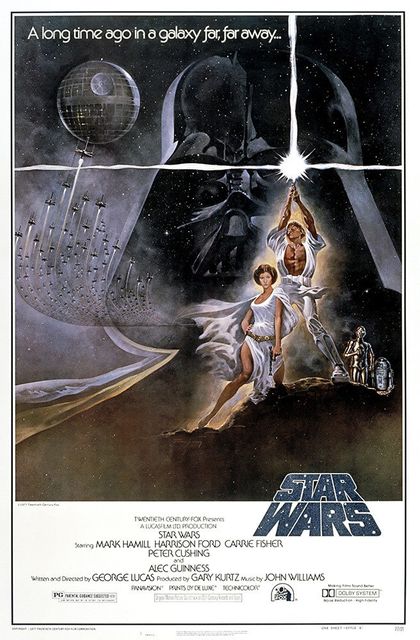
Star Wars theatrical poster from 1977. © Lucasfilm.
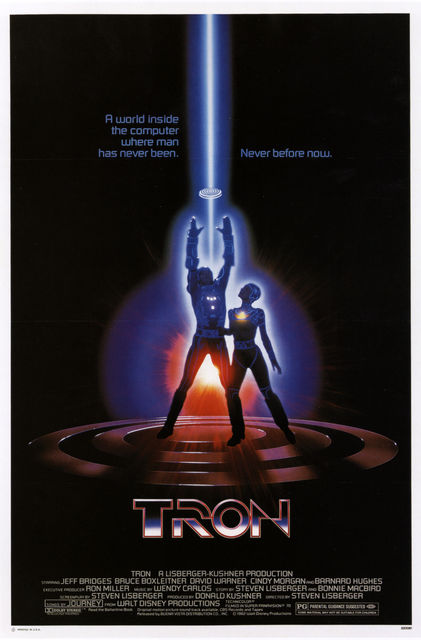
TRON theatrical poster from 1982. © Disney.
I hope this keeps awareness going for TRON, an underrated movie now a cult classic. What about TRON Legacy? That sequel, which inspired the TRON Lightcycle/Run attraction, shares a lot with the Star Wars sequels which we will explore next time.

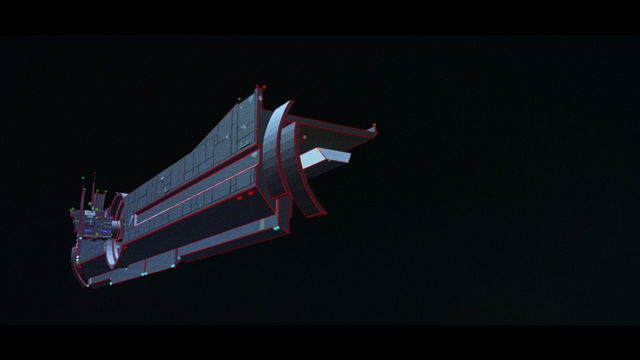
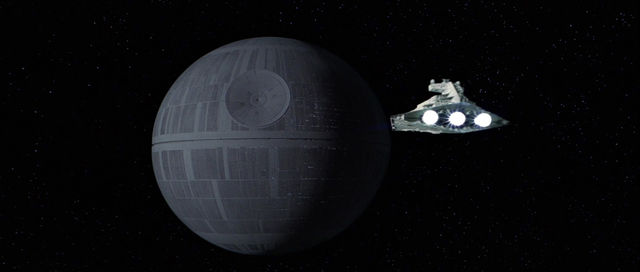
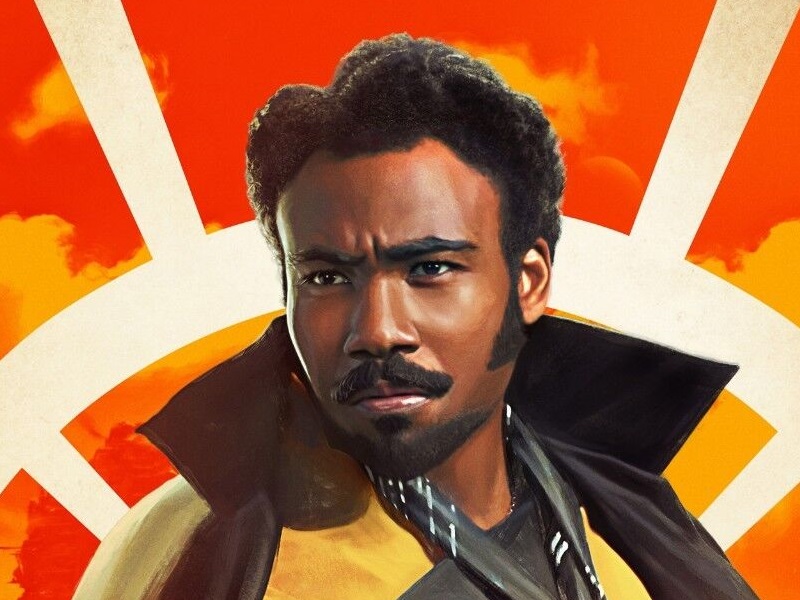
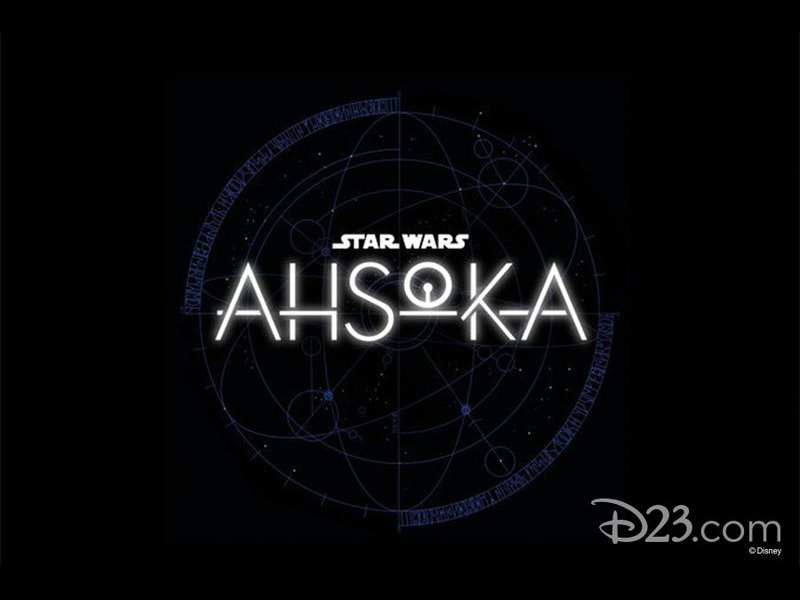
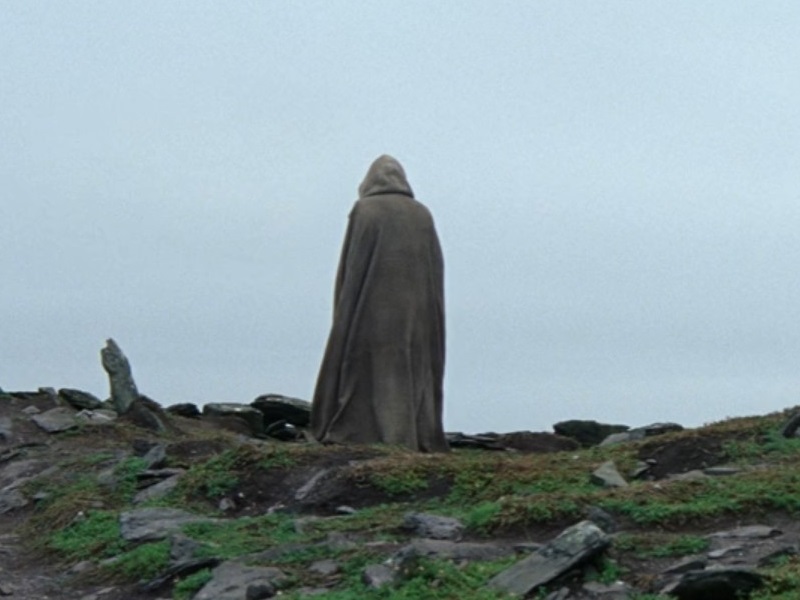
Comments